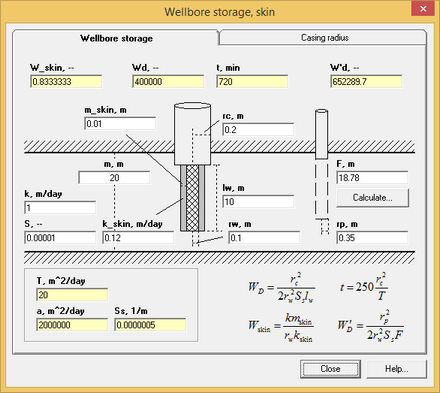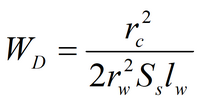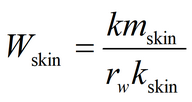The dialog window "Wellbore storage, skin" allows calculation of well bore factors and the effective radius of well that is required for interpretation of slug tests in low-permeable aquifers.
The window is opened by "File > Hydrogeologist workbench > Estimation of parameters > Wellbore storage, skin".

"Wellbore storage" tab of "Wellbore storage, skin" dialog box.
Explanatory table for tab "Wellbore storage"
Estimates the impact of wellbore storage on drawdown in a pumping well. This tool also calculates dimensionless parameters, such as skin-effect and wellbore storage. These parameters are required for analytical solutions accounting for wellbore storage and skin-effect.
"t, min" text box |
Information field that displays the calculated minimum time during which drawdowns are impacted by wellbore storage in a pumping well
rc – casing radius, m For convenience reasons, time is input in minutes in this field |
"Wd, –" text box |
Information field that displays the calculated dimensionless wellbore storage in a pumping well
|
"W'd, –" text box |
Information field that displays the calculated dimensionless wellbore storage in an observation well
rw – screen radius of a pumping well, m; rp – radius of observation well, m; F – shape factor, m |
"W_skin, –" text box |
Information field that the displays calculated dimensionless parameter
|
"k, m/day" text box |
Hydraulic conductivity, m/day. When a value is entered in this field, transmissivity is recalculated. |
"S, –" text box |
Storage Coefficient. When a value is entered in this field, hydraulic diffusivity is recalculated. |
"m, m" text box |
Thickness of aquifer. When a value is entered in this field, transmissivity is recalculated |
"rc, m" text box |
Radius of casing of pumping well, m |
"rw, m" text box |
Radius of screen of pumping well, m |
"lw, m" text box |
Length of screen of pumping well, m |
"rp, m" text box |
Radius of observation well, m |
"F, m" text box |
Shape factor, m |
"k_skin, m" text box |
Hydraulic conductivity of bore skin, m/d |
"m_skin, m" text box |
Thickness of bore skin, m |
"T, m^2/day" text box |
Transmissivity of the aquifer (auxiliary field). After entering this value, hydraulic diffusivity is recalculated |
"a, m^2/day" text box |
Hydraulic diffusivity (auxiliary field). After entering this value, Storage coefficient is recalculated |
"Ss, 1/m" text box |
Specific Storage (auxiliary field). After entering this value, Storage coefficient is recalculated |

"Casing radius" tab of "Wellbore storage, skin" dialog box.
Explanatory table for tab "Casing radius"
Calculates the effective casing radius for interpretation of slug-tests in low-permeable aquifers using Cooper's solution. The tests are conducted by injecting water in packer-isolated interval and applying additional pressure. During these tests pressure recovery is monitored. These tests are recommended for low-permeable aquifers (i.e. k< 0.001 m/d)
"Compressibility of water" text box |
Cw – water compressibility, m2/N (default value is 4.6e-10 m2/N). 1 m2/N = 1 m.c2/kg |
"Density of water" text box |
ρw – water density, kg/m3 |
"Volume of water pulsed" text box |
Vw – volume of injected water, m3 |
"Calculate the volume" option |
The checked option allows calculation of the injected water volume:
rw – well radius within the test interval, m; lw – test interval, m; rt – Radius of the pipe filled with water that connects packer and valve, m; lt – Length of pipe between packer and valve, m |
"Thickness of tested interval" text box |
Test interval. Distance between two packers |
"Well radius in tested interval" text box |
Radius of a well within the tested interval |
"Length of pipe" text box |
Length of pipe between packer and valve |
"Radius of pipe" text box |
Radius of pipe filled with water that connects packer and valve |
"Effective casing radius" text box |
Effective radius of casing, m:
g – gravity acceleration value. The calculated radius is used in Cooper's soluion |
References
Papadopulos I.S., Cooper H.H. Drawdown in a well of large diameter // Water Resources Research. 1967. Vol. 3, N 1. P. 241–244.
Moench A.F. Flow to a well of finite diameter in a homogeneous, anisotropic water table aquifer // Water Resources Research. 1997. Vol. 33, N 6. P. 1397–1407.
Bredehoeft J.D., Papadopulos I.S. A method for determining the hydraulic properties of tight formations // Water Resources Research. 1980. Vol. 16, N 1. P. 233–238.


